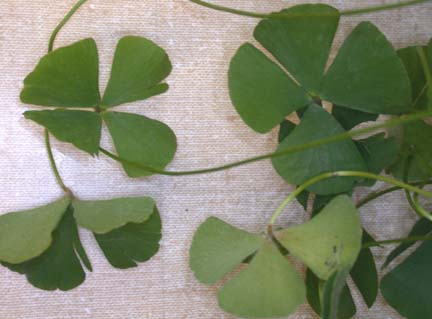Most ferns are homosporous, but there are some that are heterosporous. These are the water ferns. They belong to two different orders (review your lecture notes):
Order Marsiliales
Order Salviniales
Order Marsileales includes members of the genus Marsilea. This plant doesn’t really look like a fern. The frond actually looks like a four-leaf clover. It produces megaspores and microspores in specialized structures called sporocarps that are modified pinnae.
Order Salviniales includes members of the genus Azolla.
It is a tiny, delicate plant that can be found free-floating in ponds and lakes. It is heterosporous, with the microsporangia and megasporangia borne in separate sori, which are enclosed by an indusium. The sori and the indusium make up the sporocarp.
It is considered a nasty weed as it can outcompete native aquatic plants and is therefore no longer allowed to be imported into Canada. However, in other parts of the world it plays a very important role in agriculture and food production. In small cavities in the leaves, Azolla houses the blue green alga Anabaena. This alga fixes atmospheric nitrogen into a form which can be utilized by the fern. The Azolla-Anabaena relationship is utilised by cultures in the Far East, where it is permitted to grow on rice paddies. Eventually the rice plants shade out the fern, which dies and releases all the nitrogen into the water. This acts as a ‘natural’ fertilizer and increases the rice yield of the paddy.
HETEROSPOROUS FERNS:
FRONDS
RHIZOME
SPORANGIA




